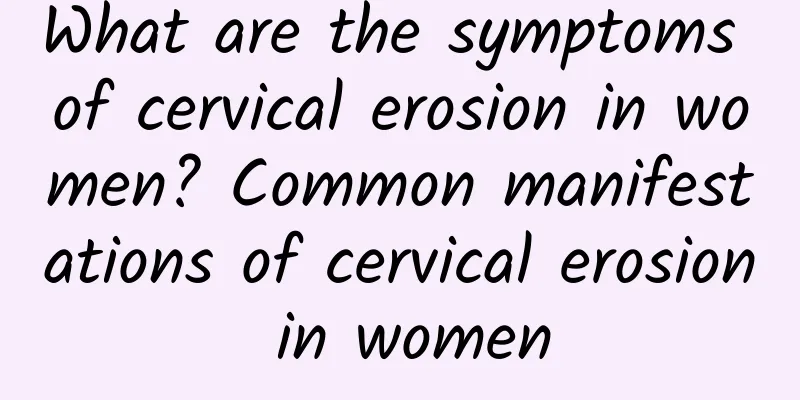What are the symptoms of cervical erosion in women? Common manifestations of cervical erosion in women

|
After cervical erosion occurs in women, the vulva may develop vulvitis or vaginitis due to the irritation of increased leucorrhea, causing itching and pain; when the inflammation is severe, it may spread along the uterosacral ligament and cardinal ligament to cause pelvic connective tissue inflammation, causing pain in the lower abdomen or lumbosacral region, accompanied by a feeling of falling; when the inflammation spreads to the bladder triangle or around the bladder, frequent urination or difficulty urinating may occur, and sexual intercourse may also cause contact bleeding or odor Cervical erosion is not true erosion, but a pseudo-erosion compared to the normal smooth cervix. It has three manifestations: at the beginning of inflammation, the erosion surface is only covered by columnar epithelium and the surface is flat, which is simple erosion; later, the erosion surface becomes uneven and granules appear on the surface, which is granular erosion; later, the erosion surface becomes more uneven and papillae appear on the surface, which is papillary erosion. There is a clear boundary between the eroded surface of the cervix and the surrounding normal squamous epithelium. Clinically, it is often divided into three categories according to the area of erosion: mild (Ⅰ°), moderate (Ⅱ°), and severe (Ⅲ°). If the erosion area accounts for 1/3 of the total area of the cervix, it is mild cervical erosion. If the erosion area accounts for 1/2 of the total area of the cervix, it is moderate cervical erosion. If the erosion area exceeds 1/2 of the total area of the cervix, it is severe cervical erosion. It is not difficult to diagnose based on clinical manifestations, but it should be noted that cervical erosion is difficult to distinguish from cervical intraepithelial neoplasia or early cervical cancer in appearance. Routine cervical scraping and endocervical canal suction should be performed, and colposcopy and biopsy should be performed when necessary to confirm the diagnosis. You should know the causes of cervical erosion There are two different types of cells in the cervix, the ones near the vagina are squamous epithelial cells, and the ones near the uterus are columnar epithelial cells, and the two types of epithelial cells have different appearances. The central part, which looks a bit like "eroded" cervix, is the appearance covered by columnar epithelium, while the relatively smooth cervix on the outside is the part of the cervix covered by squamous epithelial cells. Columnar epithelial cells and squamous epithelial cells are in a dynamic equilibrium state. The junction area of the two cells is medically named the "squamocolumnar junction". The squamosal junction is easily affected by estrogen. Before puberty, women's ovarian function is not perfect, estrogen is low, and the columnar epithelium is closer to the inside. After menstruation, the columnar epithelium is affected by estrogen and develops more toward the outside, so there are more symptoms similar to "erosion". After menopause, the estrogen level in women decreases, and the columnar epithelium begins to retreat inwards. During examination, it is found that the "erosion" disappears. Therefore, in essence, cervical erosion is actually the eversion of the columnar epithelium. Cervical erosion-like changes may also be pathological, such as congestion and edema of the cervical columnar epithelium during inflammation; or cervical intraepithelial neoplasia and early manifestations of cervical cancer. |
Recommend
What are the precautions for abortion and what are the methods of abortion?
Abortion can cause great harm to a woman's bo...
Will cervical precancerous lesions recur after surgery?
Will cervical precancerous lesions recur after su...
Stress makes you fat by breathing! Get the autonomic nervous system in check first
Obesity is most likely caused by stress! Office w...
What are the symptoms of uterine cysts
Symptoms of uterine cysts include lower abdominal...
Symptoms of vulvar itching
We need to understand the symptoms of vulvar prur...
Sugary drinks cause obesity, are they difficult to quit? Nutritionists teach 3 effective ways to quit
There are many beverage stores in Taiwan, and dri...
What are the symptoms of bacterial vaginosis?
Bacterial vaginosis is a common gynecological dis...
Afraid of getting fat, so you don’t dare eat starch, and you don’t even dare to touch pasta? Nutritionists teach you how to eat to lose weight
Afraid of getting fat, so you don’t dare eat star...
What should I do if I have pelvic effusion caused by inflammation?
What should I do if I have pelvic effusion caused...
Menopausal women can lose weight by taking androgen supplements
As we all know, women after menopause have a grad...
How to treat chronic cervicitis in women? The two best treatments for chronic cervicitis in women
Chronic cervicitis is a common gynecological dise...
Introduce the early symptoms of ectopic pregnancy
I don't know if you know the early symptoms o...
Is surgery necessary for the treatment of endometrial tuberculosis?
Western medicine focuses on the use of antibiotic...
Why is there fluid accumulation around the gestational sac? There are 4 reasons
The accumulation of fluid around the gestational ...
When can patients with vulvar leukoplakia undergo surgery?
The cause of vulvar leukoplakia is not yet clear,...









